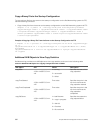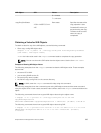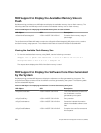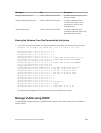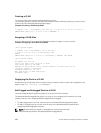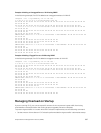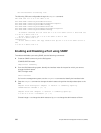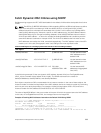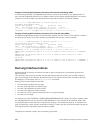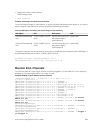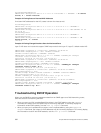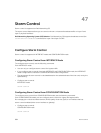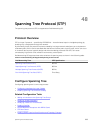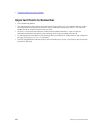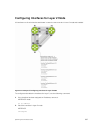
Example of Fetching MAC Addresses Learned on a Non-default VLAN Using SNMP
In the following example, TenGigabitEthernet 1/21/1 is moved to VLAN 1000, a non-default VLAN. To
fetch the MAC addresses learned on non-default VLANs, use the object dot1qTpFdbTable. The instance
number is the VLAN number concatenated with the decimal conversion of the MAC address.
---------------MAC Addresses on Force10 System------------
Dell#show mac-address-table
VlanId Mac Address Type Interface State
1000 00:01:e8:06:95:ac Dynamic Te 1/21/1 Active
---------------Query from Management Station----------------
>snmpwalk -v 2c -c techpubs 10.11.131.162 .1.3.6.1.2.1.17.7.1.2.2.1
Example of Fetching MAC Addresses Learned on a Port-Channel Using SNMP
Use dot3aCurAggFdbTable to fetch the learned MAC address of a port-channel. The instance number is
the decimal conversion of the MAC address concatenated with the port-channel number.
--------------MAC Addresses on Force10 System-------------------
Dell(conf)#do show mac-address-table
VlanId Mac Address Type Interface State
1000 00:01:e8:06:95:ac Dynamic Po 1 Active
-------------Query from Management Station----------------------
>snmpwalk -v 2c -c techpubs 10.11.131.162 .1.3.6.1.4.1.6027.3.2.1.1.5
SNMPv2-SMI::enterprises.6027.3.2.1.1.5.1.1.1000.0.1.232.6.149.172.1 = INTEGER:
1000
SNMPv2-SMI::enterprises.6027.3.2.1.1.5.1.2.1000.0.1.232.6.149.172.1 = Hex-
STRING: 00 01 E8
06 95 AC
SNMPv2-SMI::enterprises.6027.3.2.1.1.5.1.3.1000.0.1.232.6.149.172.1 = INTEGER: 1
SNMPv2-SMI::enterprises.6027.3.2.1.1.5.1.4.1000.0.1.232.6.149.172.1 = INTEGER: 1
Deriving Interface Indices
Dell Networking OS assigns an interface number to each (configured or unconfigured) physical and
logical interface.
The interface index is a binary number with bits that indicate the slot number, port number, interface
type, and card type of the interface. Dell Networking OS converts this binary index number to decimal,
and displays it in the output of the
show interface command.
Starting from the least significant bit (LSB):
• the first 14 bits represent the card type
• the next 4 bits represent the interface type
• the next 7 bits represent the port number
• the next 5 bits represent the slot number
• the next 1 bit is 0 for a physical interface and 1 for a logical interface
• the next 1 bit is unused
For example, the index 72925242 is 100010110001100000000111010 in binary. The binary interface index
for TeGigabitEthernet 1/21 of a 48-port 10/100/1000Base-T line card with RJ-45 interface. Notice that
the physical/logical bit and the final, unused bit are not given. The interface is physical, so represent this
type of interface by a 0 bit, and the unused bit is always 0. These 2 bits are not given because they are the
most significant bits, and leading zeros are often omitted.
To display the interface number, use the following command.
890
Simple Network Management Protocol (SNMP)



